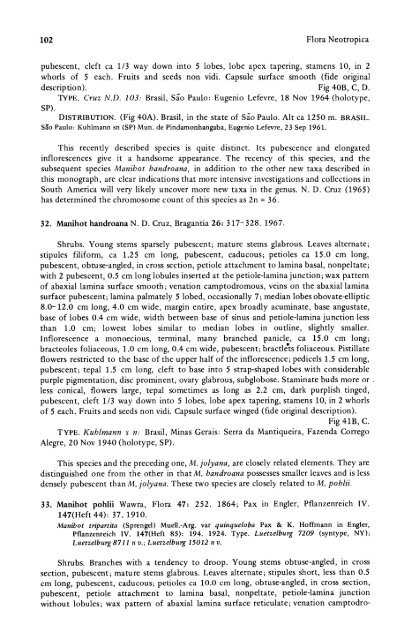Manihot Manihotoides (Euphorbiaceae) - CNCFlora
Manihot Manihotoides (Euphorbiaceae) - CNCFlora
Manihot Manihotoides (Euphorbiaceae) - CNCFlora
Create successful ePaper yourself
Turn your PDF publications into a flip-book with our unique Google optimized e-Paper software.
102 Flora Neotropica<br />
pubescent, cleft ca 1/3 way down into 5 lobes, lobe apex tapering, stamens 10, in 2<br />
whorls of 5 each. Fruits and seeds non vidi. Capsule surface smooth (fide original<br />
description). Fig 40B, C, D.<br />
TYPE. Cruz N.D. 103: Brasil, Sao Paulo: Eugenio Lefevre, 18 Nov 1964 (holotype,<br />
SP).<br />
DISTRIBUTION.<br />
(Fig 40A). Brasil, in the state of Sao Paulo. Alt ca 1250 m. BRASIL.<br />
Sao Paulo: Kuhlmann sn (SP) Mun. de Pindamonhangaba, Eugenio Lefevre, 23 Sep 1961.<br />
This recently described species is quite distinct. Its pubescence and elongated<br />
inflorescences give it a handsome appearance. The recency of this species, and the<br />
subsequent species Manibot bandroana, in addition to the other new taxa described in<br />
this monograph, are clear indications that more intensive investigations and collections in<br />
South America will very likely uncover more new taxa in the genus. N. D. Cruz (1965)<br />
has determined the chromosome count of this species as 2n = 36.<br />
32. <strong>Manihot</strong> handroana N. D. Cruz, Bragantia 26: 317-328. 1967.<br />
Shrubs. Young stems sparsely pubescent; mature stems glabrous. Leaves alternate;<br />
stipules filiform, ca 1.25 cm long, pubescent, caducous; petioles ca 15.0 cm long,<br />
pubescent, obtuse-angled, in cross section, petiole attachment to lamina basal, nonpeltate;<br />
with 2 pubescent, 0.5 cm long lobules inserted at the petiole-lamina junction; wax pattern<br />
of abaxial lamina surface smooth; venation camptodromous, veins on the abaxial lamina<br />
surface pubescent; lamina palmately 5 lobed, occasionally 7; median lobes obovate-elliptic<br />
8.0-12.0 cm long, 4.0 cm wide, margin entire, apex broadly acuminate, base angustate,<br />
base of lobes 0.4 cm wide, width between base of sinus and petiole-lamina junction less<br />
than 1.0 cm; lowest lobes similar to median lobes in outline, slightly smaller.<br />
Inflorescence a monoecious, terminal, many branched panicle, ca 15.0 cm long;<br />
bracteoles foliaceous, 1.0 cm long, 0.4 cm wide, pubescent; bractlets foliaceous. Pistillate<br />
flowers restricted to the base of the upper half of the inflorescence; pedicels 1.5 cm long,<br />
pubescent; tepal 1.5 cm long, cleft to base into 5 strap-shaped lobes with considerable<br />
purple pigmentation, disc prominent, ovary glabrous, subglobose. Staminate buds more or<br />
less conical, flowers large, tepal sometimes as long as 2.2 cm, dark purplish tinged,<br />
pubescent, cleft 1/3 way down into 5 lobes, lobe apex tapering, stamens 10, in 2 whorls<br />
of 5 each. Fruits and seeds non vidi. Capsule surface winged (fide original description).<br />
Fig 41B, C.<br />
TYPE. Kublmann s n: Brasil, Minas Gerais: Serra da Mantiqueira, Fazenda Corrego<br />
Alegre, 20 Nov 1940 (holotype, SP).<br />
This species and the preceding one, M. jolyana, are closely related elements. They are<br />
distinguished one from the other in that M. bandroana possesses smaller leaves and is less<br />
densely pubescent than M. jolyana. These two species are closely related to M. pohlii.<br />
33. <strong>Manihot</strong> pohlii Wawra, Flora 47: 252. 1864; Pax in Engler, Pflanzenreich IV.<br />
147(Heft 44): 37. 1910.<br />
Manibot tripartita (Sprengel) Muell.-Arg. var quinqueloba Pax & K. Hoffmann in Engler,<br />
Pflanzenreich IV. 147(Heft 85): 194. 1924. Type. Luetzelburg 7209 (syntype, NY);<br />
Luetzelburg 8711 n v.; Luetzelburg 15012 n v.<br />
Shrubs. Branches with a tendency to droop. Young stems obtuse-angled, in cross<br />
section, pubescent; mature stems glabrous. Leaves alternate; stipules short, less than 0.5<br />
cm long, pubescent, caducous; petioles ca 10.0 cm long, obtuse-angled, in cross section,<br />
pubescent, petiole attachment to lamina basal, nonpeltate, petiole-lamina junction<br />
without lobules; wax pattern of abaxial lamina surface reticulate; venation camptodro-

















